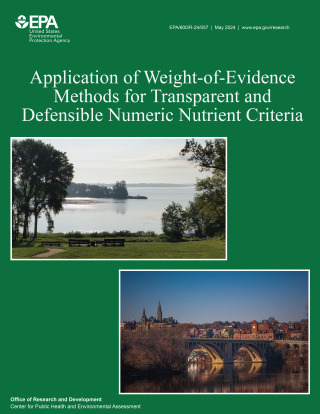Application of Weight-of-Evidence Methods for Transparent and Defensible Numeric Nutrient Criteria Report
Overview

Water quality standards are essential for protecting and restoring the condition of the United States' lakes, rivers, estuaries, and other water bodies. Since nutrient pollution continues to be a widespread problem in aquatic systems, developing numeric nutrient criteria (NNC) as part of water quality standards is a priority to enhance prospects for managing excess nutrients and their effects. In this report, we complement existing NNC guidance and support to states by discussing weight-of-evidence (WoE) methods that enable rigorous and transparent development and integration of multiple lines of evidence. This report can be helpful to those who are developing or reviewing processes for deriving NNC or NNC conclusions, such as teams of planners, decision-makers, technical advisors (for Tribes, states, and regions), and scientific researchers.
The NNC development phases (Planning, Problem Formulation, Analysis, and Derivation) align with the Basic WoE Framework steps (Assemble Evidence, Weight Evidence, and Weigh the Body of Evidence). The process is conducted within the WoE core principles of transparency, documentation, and communication. The following are take-home messages for WoE's role in strengthening each phase of NNC development.
- Planning Phase - Activities undertaken during planning provide a transparent foundation for developing NNC; transparency is a core principle of WoE. Grouping water bodies during planning is a process in which WoE can be applied when diverse evidence needs to be combined.
- Problem Formulation Phase - Selecting endpoints during Problem Formulation is also a process in which WoE can be applied when diverse evidence needs to be combined. Conceptual models developed during Problem Formulation can inform what evidence should be assembled in the Analysis Phase.
- Analysis Phase - This phase includes assembling evidence and weighting evidence. Unbiased assembly of evidence is best practice and can ensure NNC are based on transparent data and information of sufficient amount and quality. Weighting evidence by establishing, objectively evaluating, and documenting qualities of that evidence shows how much influence individual evidence will have on overall NNC conclusions.
- Criteria Derivation Phase - This phase includes weighing the body of evidence by integrating and interpreting evidence, as well as communicating conclusions. Methods for integrating evidence to derive criteria can range from simple to sophisticated; selected methods should be logical, informed by evidence availability and stakeholder needs, and communicated clearly.
This work is primarily based on Weight-of-Evidence in Ecological Assessment (U.S. EPA 2016), which focuses on decision theory and a robust body of work and experience in land and water-based condition, causal, and risk assessments. The methods, contexts, and examples selected and described in the present publication relate to nutrient criteria development in freshwater ecosystems.
History of Application of Weight-of-Evidence Methods for Transparent and Defensible Numeric Nutrient Criteria
| Date | Description |
|---|---|
| May 2024 | EPA released the final report on the website. |
| November 2023 | EPA conducted an external review of the report. |
| April 2023 | EPA conducted an internal review of the draft report. |
Access the Report and Training Materials
Read the Report
WoE Documentation User Manual (pdf)
Training Video
This video provides a short training on Weight-of-Evidence methods.
Related Research
- EcoDIVER: Ecological Database and Interactive Visualizations of Evidence Records
- Ecological Risk Assessment
- Nutrients Research
- Nutrient Scientific Technical Exchange Partnership & Support (N-STEPS) Online
Technical Questions
Have a technical question about the report? Please contact Caroline Ridley.
